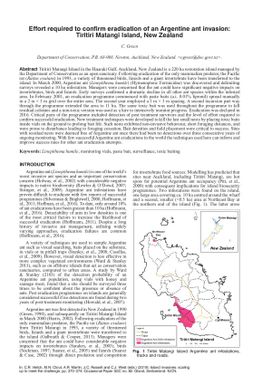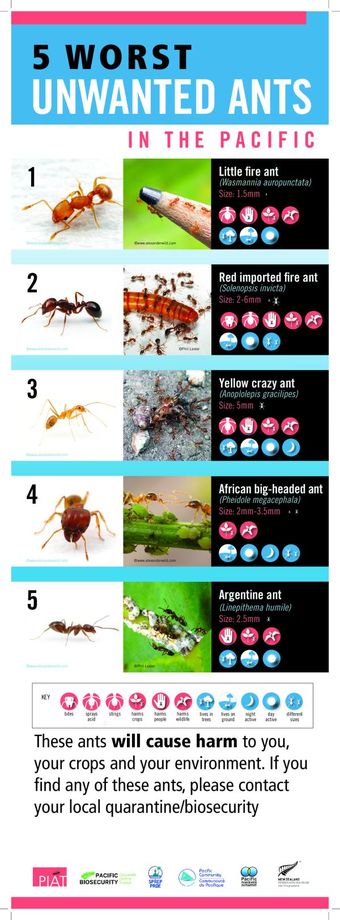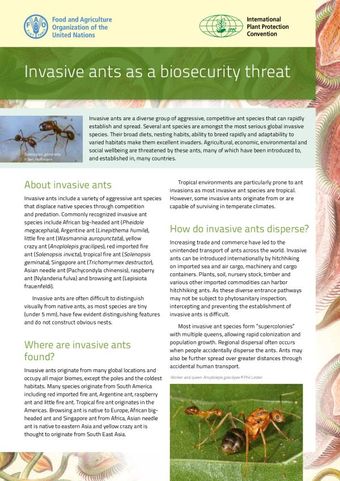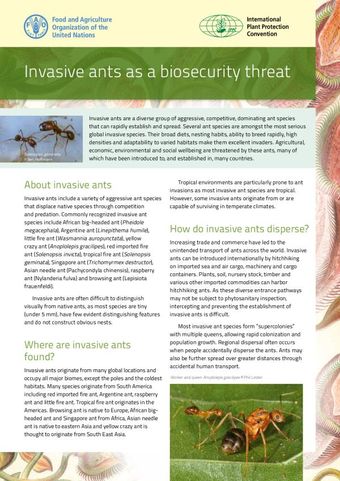Effort required to confirm eradication of an Argentine ant invasion: Tiritiri Matangi Island, New Zealand
- Description:
- Tiritiri Matangi Island in the Hauraki Gulf, Auckland, New Zealand is a 220 ha restoration island managed by the Department of Conservation as an open sanctuary. Following eradication of the only mammalian predator, the Paci?c rat (Rattus exulans) in 1993, a variety of threatened birds, lizards and a giant invertebrate have been transferred to the island. In March 2000, Argentine ant (Linepithema humile) (Hymenoptera: Formicidae) was discovered and delimiting surveys revealed a 10 ha infestation. Managers were concerned that the ant could have signi?cant negative impacts on invertebrates, birds and lizards. Early surveys con?rmed a dramatic decline in all other ant species within the infested area. In February 2001, an eradication programme commenced with paste baits (a.i. 0.01% ? pronil) spread manually in a 2 m × 3 m grid over the entire area. The second year employed a 1 m × 3 m spacing. A second incursion part way through the programme extended the area to 11 ha. The same toxic bait was used throughout the programme to kill residual colonies and a non-toxic version was used as a lure to intensively monitor progress. Eradication was declared in 2016. Critical parts of the programme included detection of post treatment survivors and the level of e?ort required to con?rm successful eradication. New treatment techniques were developed to kill the last small nests by placing toxic baits inside vials on the ground to prolong bait life. Such nests exhibited non-invasive behaviour, short foraging distances, and were prone to disturbance leading to foraging cessation. Bait densities and ?eld placement were critical to success. Sites with residual nests were deemed free of Argentine ant once there had been no detections over three consecutive years of ongoing monitoring. With few successful Argentine ant eradications in the world the techniques used here can inform and improve success rates for other ant eradication attempts.
- Display date:
- 2019
- Collections:
- Secretariat of the Pacific Regional Environment Programme (SPREP)
- Publisher:
- International Union for Nature Conservation (IUCN)
- Content partner:
- Secretariat of the Pacific Regional Environment Programme (SPREP)
- Availability:
- Not specified
-
Copyright status: All rights reservedFind out more about what you are able to do with this itemThis item is all rights reserved, with means you'll have to get permission from Secretariat of the Pacific Regional Environment Programme (SPREP) before using it. For more information, please see our use and reuse page.What can I do with this item?Non-infringing useNZ copyright law does not prevent every use of a copyright work, and this item may be hosted by an international institute or organisation. You should consider what you can and cannot do with a copyright work.No sharingYou may not copy and/or share this item with others without further permission. This includes posting it on your blog, using it in a presentation, or any other public use.No modifyingYou are not allowed to adapt or remix this item into any other works.No commercial useYou may not use this item commercially.
Related items
Welcome and warm Pasifik greetings
The information on this site has been gathered from our content partners.
The names, terms, and labels that we present on the site may contain images or voices of deceased persons and may also reflect the bias, norms, and perspective of the period of time in which they were created. We accept that these may not be appropriate today.
If you have any concerns or questions about an item, please contact us.



